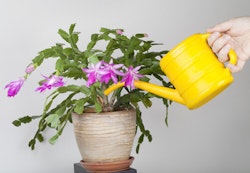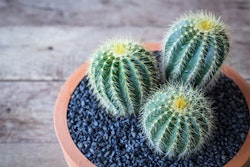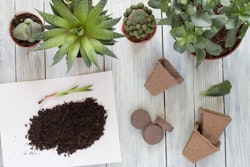Care for Cactus in Containers
 Cactus in Containers - Care
Cactus in Containers - Care
Cacti are a group of succulent plants that do well in containers under the right conditions. They are native to the New World. These plants are diverse both in form and color, clumping or solitary. They can range in size from very small to more than 40 feet tall. Most cacti are best grown outdoors in filtered sun or on a bright patio. Some can tolerate full sun. Smaller species may be kept in a container. The larger varieties can start out in a container but will outgrow their pots and can be moved to the landscape—depending on the species—where they can enjoy more growing space.
Soil
 Most cacti should be grown in mineral-based soils consisting of a mixture of sands, silts, and gravel (good drainage) and which does not harden when dry. Cacti from tropical dry forests and high altitude regions benefit from a mix containing 25-50% of decomposed organic matter. Epiphytic cacti such as Christmas cacti like a 1/3 - 1/3 - 1/3 mix of bark, pumice and decomposed organic matter. No peat should be used in any of these mixes. Organic matter consisting of well decomposed plant material or worm castings is acceptable. If you wish to use peat-based soil mixes, you can, provided that you re-pot every 2-3 years.
Most cacti should be grown in mineral-based soils consisting of a mixture of sands, silts, and gravel (good drainage) and which does not harden when dry. Cacti from tropical dry forests and high altitude regions benefit from a mix containing 25-50% of decomposed organic matter. Epiphytic cacti such as Christmas cacti like a 1/3 - 1/3 - 1/3 mix of bark, pumice and decomposed organic matter. No peat should be used in any of these mixes. Organic matter consisting of well decomposed plant material or worm castings is acceptable. If you wish to use peat-based soil mixes, you can, provided that you re-pot every 2-3 years.
Looking for a great soil for Cactus? SummerWinds Nursery recommends E.B. Stone's Organics Cactus & Succulent Potting or Planting Mix, available at your local SummerWinds Nursery.
Water
 It is completely false that cacti need no water; after all, they are composed principally of water. What is true is that they require less water than violets, but more than a rock. Water cacti when they are actively growing or if they are wilting. Wilting appears as shrinkage of the plant or wrinkling of the plant's surface. Most cacti grow actively in the spring and summer, but some grow in the other seasons as well so you will need to watch them carefully. Water only when the soil is nearly dry. You can test for dry sub-surface soil with your finger, a wooden pencil or popsicle stick (damp soil will cling to the wood), or (best) with a moisture meter. Water all of the soil thoroughly until the water runs out of the drain holes. Use only pots with drain holes, and if you use pots with saucers, be sure to empty the saucer after watering. The rule is no swamps. The warmer the weather, the more frequently water is needed, unless the plant is dormant. In winter, little or no water is needed, even for cacti in active growth, because it is cool. Natural rain is very beneficial, and water may be applied from overhead (which helps clean the plant), at the soil line, or from below. Remember not to let the plant stand in a saucer of water.
It is completely false that cacti need no water; after all, they are composed principally of water. What is true is that they require less water than violets, but more than a rock. Water cacti when they are actively growing or if they are wilting. Wilting appears as shrinkage of the plant or wrinkling of the plant's surface. Most cacti grow actively in the spring and summer, but some grow in the other seasons as well so you will need to watch them carefully. Water only when the soil is nearly dry. You can test for dry sub-surface soil with your finger, a wooden pencil or popsicle stick (damp soil will cling to the wood), or (best) with a moisture meter. Water all of the soil thoroughly until the water runs out of the drain holes. Use only pots with drain holes, and if you use pots with saucers, be sure to empty the saucer after watering. The rule is no swamps. The warmer the weather, the more frequently water is needed, unless the plant is dormant. In winter, little or no water is needed, even for cacti in active growth, because it is cool. Natural rain is very beneficial, and water may be applied from overhead (which helps clean the plant), at the soil line, or from below. Remember not to let the plant stand in a saucer of water.
Light
 Cacti—except epiphytes—are best grown outdoors. Interiors are usually too dark for good growth unless assisted by high-intensity lights. Cacti grown indoors very frequently develop pointy heads or other forms of stem stretching. Cacti should be grown outdoors in conditions ranging from full sun to 50% shade, depending on the species and on the size of the plant. If the cactus gets too much sun it will sunburn, which results in a yellowing of the skin, progressing to a browning (killing) of the skin on the sunniest side. If this occurs, provide shade immediately. Eastern exposures are gentlest, western sunlight is fiercest.
Cacti—except epiphytes—are best grown outdoors. Interiors are usually too dark for good growth unless assisted by high-intensity lights. Cacti grown indoors very frequently develop pointy heads or other forms of stem stretching. Cacti should be grown outdoors in conditions ranging from full sun to 50% shade, depending on the species and on the size of the plant. If the cactus gets too much sun it will sunburn, which results in a yellowing of the skin, progressing to a browning (killing) of the skin on the sunniest side. If this occurs, provide shade immediately. Eastern exposures are gentlest, western sunlight is fiercest.
Fertilization
 Container grown plants need fertilizer because the soil will be exhausted of nutrients over time. Frequency of fertilization depends on how fast you want the plant to grow and the strength, or concentration, of the fertilizer that you use. Remember that fast growth may produce weak cells, leading to over-tenderness. Fertilize at least once every four weeks during the plant’s growing season. Use the concentration recommended for ornamental plants on the fertilizer package. If you fertilize with each watering, cut the strength of the solution accordingly. Use a low nitrogen fertilizer, such as 10-30-20. As a slow-acting organic fertilizer, fish emulsion is effective. We recommend Grow More Cactus Juice plant food.
Container grown plants need fertilizer because the soil will be exhausted of nutrients over time. Frequency of fertilization depends on how fast you want the plant to grow and the strength, or concentration, of the fertilizer that you use. Remember that fast growth may produce weak cells, leading to over-tenderness. Fertilize at least once every four weeks during the plant’s growing season. Use the concentration recommended for ornamental plants on the fertilizer package. If you fertilize with each watering, cut the strength of the solution accordingly. Use a low nitrogen fertilizer, such as 10-30-20. As a slow-acting organic fertilizer, fish emulsion is effective. We recommend Grow More Cactus Juice plant food.
Transplanting/Repotting
 Transplanting should be done when the plant has filled the pot, or, in the case of tall species, when the pot becomes top-heavy. If the soil in the new destination is the same or similar to that in which the plant is growing, simply shake the plant free of its container, keeping the soil ball intact if possible. Rough up the edges of the soil ball and then replant, keeping the soil level the same as the former location. If the soil/root ball collapses, wait a week to let the roots callus, then plant, using dry soil. If you are changing soil types from organic to mineral, first remove all old soil from the roots using an old toothbrush to get at the most stubborn bits. Cut off any broken roots and let dry until all wounds have callused over, then re-pot or plant using dry soil to fill in so that the soil will flow and fill in all air pockets. Wait a few days, then water in to settle the soil. It is best to transplant when the plant is actively growing, but if you must, you can do it any time.
Transplanting should be done when the plant has filled the pot, or, in the case of tall species, when the pot becomes top-heavy. If the soil in the new destination is the same or similar to that in which the plant is growing, simply shake the plant free of its container, keeping the soil ball intact if possible. Rough up the edges of the soil ball and then replant, keeping the soil level the same as the former location. If the soil/root ball collapses, wait a week to let the roots callus, then plant, using dry soil. If you are changing soil types from organic to mineral, first remove all old soil from the roots using an old toothbrush to get at the most stubborn bits. Cut off any broken roots and let dry until all wounds have callused over, then re-pot or plant using dry soil to fill in so that the soil will flow and fill in all air pockets. Wait a few days, then water in to settle the soil. It is best to transplant when the plant is actively growing, but if you must, you can do it any time.
Pests and Diseases
Cacti have few diseases and pests. Most problems are environmental.
- Pointy heads in globular cacti or stringy narrow stems in others—Etiolation caused by too little light—give more light.
- Yellowing or browning of the skin: Especially on the sunny side—Sunburn—give more shade immediately.
- Wilting, wrinkling, shrinkage: Dry soil, needs water. If soil is wet, then roots have died due to swamping—remove from damp soil, re-root, and transplant.
- White cottony masses or white rice-like objects on plants: Cochineal scale or mealy bug—wash off with hard jet of water, or apply alcohol or a pesticide for scale insects. Inspect plant often to check for recurrence.
- Very fine spider webbing in the spines: Sometimes with red bead-size mites, and graying of the skin—Red spider mite. Wash off the water and use overhead watering to prevent reoccurrence. In severe cases use miticide treatment.
- Large larvae (grubs) tunneling inside stems, large black adults feeding on tips of plant: Longhom beetle—remove adults at dawn and kill, or place them in a large prickly pear cactus clump some distance away.
- Plant being eaten: Rabbit, rodent or javelina damage—Protect plant with wire cage or move out of reach.
- Wet rot anywhere on the stem: Bacterial rot (Erwinia carnegieana)—Cut away all rotted tissue down to fresh, undiscolored tissue. Air dry. Do not fill in holes.
- Dry rot on tips or in the whole plant: Fungal dry rot (Helminthosporum cactivorum)—Cut away all dried and discolored tissue. Air dry.
Source: Desert Botanical Garden article, “Care of Cacti in Containers” at www.dbg.org
Cactus Varieties
Want to explore the wide world of cacti? Click below, for a list of local favorites.

